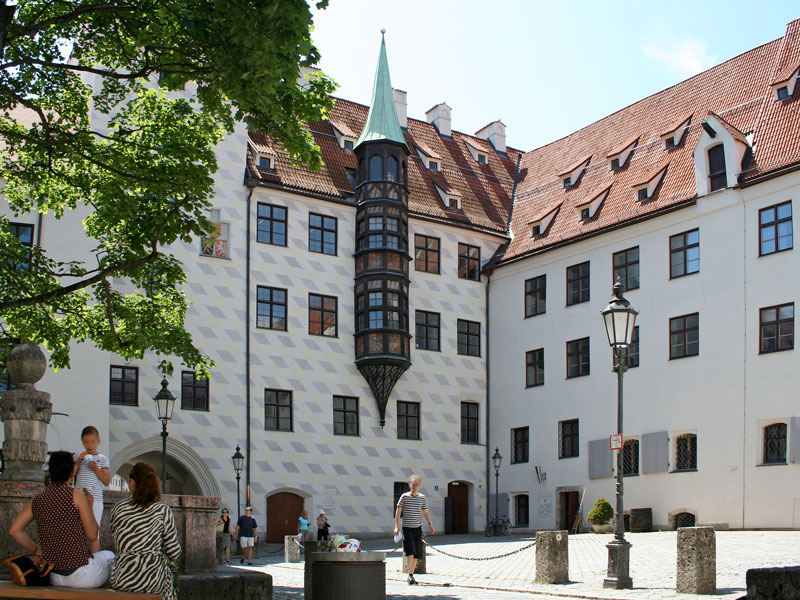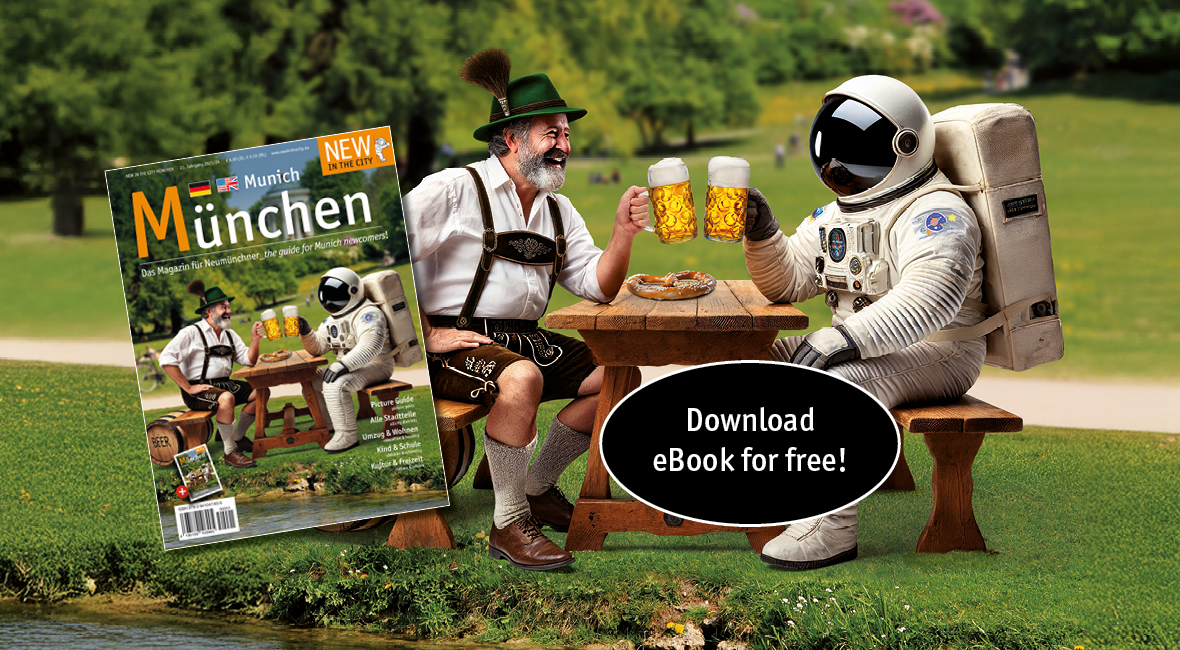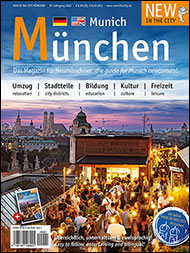 Alter Hof, © NEW IN THE CITY
Alter Hof, © NEW IN THE CITY
The first newcomers arrived at the banks of the Isar a thousand years ago. Munich has come a long way since then, a way that was sometimes smooth and easy, sometimes hard and rocky. Thus the little village developed into a fully grown city over the centuries - a city with some scars, lots of traditions and a colorful past. We will now take you on a time trip spanning a millenium of Munich history.
Walking through Bavaria’s biggest city today, it is hard to believe, but time travelers going back to downtown Munich in the year 500, would find themselves on a green meadow. There would not be a single building, no road, probably not one human being in sight. The visitors from the future might go unnoticed until around the year 1,000 when the first Munich citizens would probably react to them by saying a short prayer - after all, Munich’s first settlers were monks. It was at this time when the Benedictine Monastery at Lake Tegern opened a small branch on the site of modern downtown Munich. This settlement soon developed into a small village, “Apud Munichen” (by the monks).
However, Munich was not officiall founded until June 14, 1158, when German Emperor, Friedrich Barbarossa (Frederic with the red beard) gave Henry the Lion, Duke of Welfen, permission to operate a bridge over the Isar he had already built. Since the important bridge was located close to the small village, “Munichen” the settlement began to grow more and more. Going to the year 1175, our time travelers may now find themselves within the first city walls being erected to protect the village that now covered some 15 hectares and had no more than 2,500 citizens. As time went by, little Munich became more and more important.
In 1180, Otto von Wittelsbach was appointed sovereign of Bavaria. The consequence: For centuries to come time travelers would find members of the Wittelsbach dynasty on the Bavarian throne. They made Munich their place of residence. In 1328, Ludwig the Bavarian was the first Wittelsbacher to be elected Emperor of Germany. Under his reign a second wall was built around Munich and the Isar Gate was erected. The city now covered some 90 hectares and already had a popularion of 12,000. Our next stop is the early 16th century: In 1506 Munich became the capital of entire Bavaria. Having 700 resident clergymen led William IV. to pass a law regulating the brewing of beer in 1516: From now on the popular drink may only be made using hops, malt and water. A time traveler alone could find out wether modern beer actually still tastes like in the old days. At least the Purity Law is still valid in Germany, making it the world’s oldest law regulating food.
Visiting the year 1632 on the other hand, is not such a good idea. During the 30-year War Munich was occupied by the Swedes and in fall of that year the Black Death killed 1,500 people. Instead one may want to visit the year 1674 when Kurfürst (elector) Ferdinand Maria had Nymphenburg Castle built for his wife just outside Munich, thus thanking her for the birth of their son, Max Emanuel. The boy’s future however, was not as bright as the country palace’s garden may have promised: Max Emanuel lost the Spanish War of Succussion. In 1705 Munich’s nine years under Austrian occupation began. An uprising on December 25, 1705 ended in bloodshed. 3,000 freedom fighters were killed. The event was later recorded as the “Sendlinger Mordweihnacht” (Murder Christmas of Sendling). In the second half of the century, Munich’s population has already risen to 30,000 and the city now covers 1,539 hectares.
In 1777 Kurfürst Karl Theodor, merely a distant relative of House Wittelsbach, ascends the Bavarian throne. He was so unpopular that people actually celebrated in the pubs when he died in 1799. Still, he left his mark on Munich: In 1789, Karl Theodor had a former hunting ground turned into a city park, the English Garden. Fortunately you do not need a time machine to relax. The Englishe Garten remains a recreational area popular with natives and visitors alike. In case one wants to meet the first Bavarian King or even French Emperor Napoleon Bonaparte, a trip to the early years of the 19th century is a good idea.
In 1800, Napoleon occupied Munich and in 1801 Max I. Joseph, still Bavarian Kurfürst at the time, changed sides and allied himself with the French. This signified a giant leap both for the City of Munich and the State of Bavaria. A modern administration, a legal system based on fact and a new constitution were established, new roads and squares were built, church property was dispossessed and nationalized. In 1806 Bavaria was made an independent kingdom at last - governed by Max I. Joseph, now a king. Munich continued to grow. Back then a traditional event, that was destined to become famous throughout the world, was first celebrated: the Oktoberfest.
In 1810, a horse race took place on a meadow just outside the city to celebrate the wedding of Crown Prince Ludwig and his bride, Therese Charlotte Luise. This event was such a great success that it was repeated annually, becoming bigger and bigger over the years. Finally the site of the event was named after the bride, Theresienwiese. The three kings who governed Bavaria during the 19th century turned Munich into a modern metropolis. For example, the old Bavarian University was moved to Munich and in 1840 public transportation began with a train line connecting the city with Lochhausen.
The buildings on Ludwig- and Maximilianstraße were erected, the “Königsbau” and the “Festsaalbau” were added to the royal residence. The Königsplatz, the Old Pinakothek (an art gallery), the Ruhmeshalle (Hall Of Fame) and the Bavaria Statue overlooking the Theresienwiese, as well as Munich’s Central Station, the Hauptbahnhof, were built. In 1854, the first couple of suburbs were incorporated into Munich and in 1860 Munich’s first sports club was founded: the TSV 1860 München that still exists today. Particularly the so-called “Fairy-Tale King" Ludwig II., who reigned 1864 thru 1886, won fame for building the Neuschwanstein, Herrenchiemsee and Linderhof Castles. In 1867 he had the new town-hall on Marienplatz erected. On the other hand, Bavaria was forced to join Bismarck’s German Union after the was against France, thus losing its sovereignty.
Yet Munich’s population continued to grow tremendously. In 1895 the city already had 400,000 citizens, around 1900 there were 500,000. In 1901, Munich was Germany’s third biggest city, only surpassed by Berlin and Hamburg - and the fittest one: the FC Bayern München, founded in 1900, already had more members than any other German sports club. Only time travelers know that World War I was only a few years away at the time. The years just before the war would might have been the perfect time to get spare parts for a time machine: In addition to various arms factories and an airplane factory, the Bavarian Motor Works (BMW) were founded for armament purposes. However, should time travelers get stuck in Munich between 1914 and 1918, no need to panic: the city was not affected directly by the war. The chance of survival was pretty good for anyone who was not enlisted as a soldier. About 13,000 citizens of Munich were killed on the battlefields.
After August 1918 Munich itself became a horrible place to be. The years until after World War II were dominated by famines, poverty, riots and high unemployment rates. On November 7, 1918 Bavaria was proclaimed a republic in Munich and the last Bavarian king, Ludwig III. fled. On the way to a new political order, revolutions, riots and Hitler’s unsuccessful attempt at a national socialist revolution in 1923 shook Munich. Finally, during World War II 45 percent of Munich’s buildings were destroyed and almost 7,000 people were killed by bombs, another 25,000 citizens died on the battlefields. While the population dropped to under 400,000, in 1949, the year the Federal Republic Of Germany was founded the city already had 800,000 citizens. Restoration and the “Wirtschaftswunder” (the miraculous growth of the German economy during the 1950s) was another great leap in Munich’s history. In December 1957 the population first exceeded one million.
During the 1960s the net of S-Bahn (commuter trains) and U-Bahn (subway) was established. Sports fans might want to beam to the 1970s: In 1972 Munich and its suburbs hosted the XX. Olympic Summer games, that were unfortunately overshadowed by the attack of Arab terrorists on the Israeli team. Eleven athletes and a policeman were killed, five of the terrorists died, too. The 1974 FIFA World Cup commenced without disturbances of any kind. Beating the Netherlands 2:1-Sieg Germany won the title at Munich’s Olympic Stadium. Today the city has a population of more than 1.3 million.
The beginning of the new millenium is marked by an atmosphere of innovation. The Franz-Josef-Strauß Airport in Erding that was opened in 1992, is Germany’s second most important airport after Frankfurt. In 1998 the new trade fair grounds were opened on the site of Munich’s former airport in Riem were a new district will be developed step by step. In 2005 a park was established here for the National Horticultural Show. For the FIFA World Cup 2006, a new soccer stadium, the Allianz Arena, was built at a cost of 280 million Euros. It was opened in May 2005, another highlight of Munich’s skyline. But the trip down the ages continues. And it is up to every Munich newcomer to help shaping the city’s future - always keeping in mind how far a small monastery and bridge have come in 850 years.






